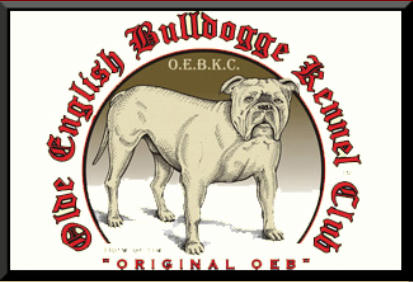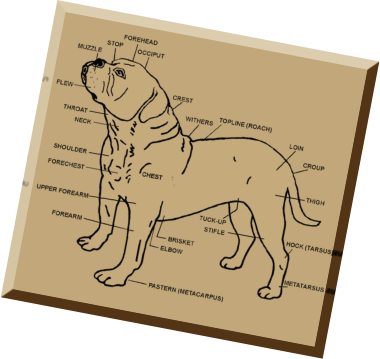

President
Vice President
Bonnie Rich
Treasurer
Marian Knott
Nick Mantzavas



Acceptance and use of the information contained on this web site constitutes an acknowledgement that the user
hereby releases and indemnifies OEBKC, and its officers, directors, members, and agents from any and all liability
and damages sustained by the user as a result of any information obtained from this web site.
Standard
GUARDIAN GROUP (UKC Standard as of January 1, 2014)
Breed Standard
HISTORY
Bulldogs were created for the English sport of bull baiting, practiced from approximately 1100 until
1835. By the middle of the 1800’s, the sport was no longer legal, and the athletic bulldog quickly began
to disappear. Because the bulldog was revived solely for the conformation venue, selective breeding
for appearance severely compromised the health and lifespan of this once agile, athletic and happy
breed.
In 1971 a breeding project began using a linebreeding scheme developed by Dr. Fechimer of Ohio State
to rapidly achieve a purebred dog. The goal of this project was to return the bulldog to the appearance
of the “Regency-Period” bulldog, now named the Olde English Bulldogge (OEB) to clearly differentiate
the new breed from the modern English Bulldog.
Today’s Olde English Bulldogge matches the looks of the bull baiting dog of the early 1800’s. They are,
first and foremost, excellent companions, while also possessing the drive, temperament and agility to
perform in numerous working venues as well as being service dogs. The revival of a healthy dog with
the longevity to live well into its teens is a primary goal.
The Olde English Bulldogge was recognized by the United Kennel Club on January 1, 2014.
GENERAL APPEARANCE
The Olde English Bulldogge is a muscular, medium sized dog of great strength, and possessed of fluid,
agile movement. He is well balanced and proportioned, while appearing capable of performing without
any breathing restrictions in either heat or in cold.
Disqualifications: Unilateral or bilateral cryptorchid.
CHARACTERISTICS
The disposition of the Olde English Bulldogge is confident, friendly and alert. An OEB should be an
animated and expressive dog, both in and out of the show ring.
Fault: Shyness in a mature dog.
Disqualification: Viciousness or extreme shyness.
HEAD
Serious Faults: Excessive wrinkle, lack of pigment around eyes, nose or mouth.
SKULL – The skull is large and well-proportioned to the dog’s muscular body and prominent shoulders.
There is a defined furrow from the stop to the occiput.
Serious Faults: Narrow skull; domed forehead.
MUZZLE – The muzzle appears square, wide and deep, with definite layback. Distance from the tip of
the nose to the stop does not exceed one-third of the distance from the tip of the nose to the occiput.
Flews are semi-pendulous.
TEETH - Bite is undershot or reverse scissors. Lower jawbone is moderately curved from front to back.
Broken, chipped or extracted teeth are not to be faulted. Exposed canine teeth are to be faulted.
Disqualifications: Wry jaw; overbite.
NOSE - Nostrils are wide, with a line running vertically between nostrils from the tip of nose down to
the bottom of the upper lip. Nose is large and broad in relationship to the width of the muzzle. Nose
color is black.
Serious Fault: Slit nostrils.
Disqualification: Any color nose other than black.
EYES - Eyes are medium in size and almond shaped. They are set wide and low, level with the top of
the muzzle. Color is dark to light brown, with black pigmented eye rims.
Disqualifications: Any eye color other than brown; wall eyes; crossed eyes.
EARS - Ears are rose, button or tulip. Rose is preferred. They are set high, wide and to the back outer
edge of the skull. The ears are small in size.
NECK
The neck is medium length, wide, and slightly arched. It is slightly smaller than the head at their
junction, and widens to point of the shoulders. Loose from jaw to chest, forming a double dewlap.
FOREQUARTERS
Shoulders are broad, heavily muscled and have a separation between the shoulder blades. Moderate
angulation of the shoulder blade, which should also be roughly equal in length to the upper foreleg.
ELBOWS - Elbows should be neither in nor out.
FORELEGS - Forelegs are of medium bone, set straight, with strong pasterns.
BODY
Sturdy, powerful and slightly rectangular when viewed from the side. Chest is wide and deep, with a
muscular brisket, and ribs well-sprung. There should be a distinct tuck between ribs and hindquarters.
There is a dip behind the whithers; topline rises over the loin with the appearance of a slight roach.
Faults: Narrow rib cage.
HINDQUARTERS
Hind legs are well muscled and have the appearance of being slightly longer than the forelegs.
Viewed from the rear, the hind legs should be straight, parallel and set apart. Angulation is moderate.
Fault: Cow-hocked or bow-hocked.
FEET
Feet are strong and rounded, with well-arched toes.
Faults: Flat feet or splayed toes.
TAIL
The characteristic tail is often referred to as a crank or pump handle tail. Straight tails are also
acceptable. The tail is set on as a natural extension of the topline, and tapers to a point. When the dog
is relaxed, the tail is carried low and extends approximately to the hock. When the dog is moving, the
tail is carried level with the backline. When the dog is excited, the tail may be carried in a raised,
upright position (challenge tail), but never curled over the back (gay tail).
Faults: Tail curling 360 degrees or carried up over the back.
Disqualifications: Kinked, docked, natural bob, or screw tail (a kinked tail is a tail with one or more
sharp bends).
COAT
Coat is short, close and of medium density. It should be shiny, showing good health.
Faults: Fringe, feather or curl in the coat.
COLOR
Accepted color patterns include brindle, and solid colors, with or without white.
Brindle is defined as a fine streaked or striped effect or pattern of black or tan hairs with hairs of a
lighter or darker background color. Shades of colors accepted include red brindle, fawn brindle, brown
brindle, and grey brindle; either solid or pied.
Accepted solid colors include white, fawn, red, red sable, fawn sable, or black; with or without white.
Disqualifications: Albinism. Blue, and black with rust /mahogany/tan trim.
GAIT
At a trot, the gait is smooth, powerful, energetic and confident. A slight roll to the gait should not be
faulted. Footfalls approach the centerline as trotting speed increases.
When viewed from the front or rear, the legs turn neither in nor out, nor do feet cross or interfere with
each other. From the side, the front legs should reach out smoothly with no obvious pounding.
HEIGHT AND WEIGHT
Overall balance is never to be sacrificed in favor of size.
Dogs should be 60 to 80 pounds, and 17 to 20 inches at the withers. Bitches should be 50 to 70 pounds,
and 16 to 19 inches at the withers.
Neither dog nor bitch appears fat. Measurements apply at age 2 or older. Weight of both dog and bitch
should be proportionate to height.
DISQUALIFICATIONS
( A dog with a Disqualification must not be considered for placement in a conformation event, and must
be reported to UKC.)
Unilateral or bilateral cryptorchid.
Viciousness or extreme shyness.
Albinism.
Wry jaw.
Overbite.
Any color nose other than black.
Any eye color other than brown.
Wall eyes
Crossed eyes.
Kinked, docked, natural bob, or screw tail
(a kinked tail is a tail with one or more sharp bends).
Blue, black, and black with rust or mahogany.


Secretary
Jennifer Lussier





























